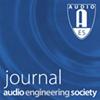MPEG-I沉浸式音频-虚拟/增强现实音频标准的参考模型
IF 1.6
4区 工程技术
Q3 ACOUSTICS
引用次数: 3
摘要
MPEG-I沉浸式音频是MPEG音频集团(ISO/IEC JTC1/SC29/WG6)正在开发的一项即将推出的标准,旨在为具有六个自由度(6DoF)的虚拟和增强现实(VR/AR)应用程序提供音频的压缩表示和渲染。MPEG-I沉浸式音频支持复杂虚拟场景的比特率高效和高质量存储/传输,包括具有空间范围和不同辐射特性的源(如乐器),以及声学相关元素(如墙壁、门、遮挡物)的几何描述。渲染过程包括对房间声学和复杂声学现象的详细建模,如由于声学障碍和多普勒效应引起的遮挡和衍射,以及与用户的互动。基于许多贡献,本文报告了MPEG-I沉浸式音频标准化过程的现状及其第一个技术参考模型体系结构。MPEG-I沉浸式音频建立了VR/AR领域第一个长期稳定的音频格式规范,可用于许多消费者应用,如广播、流媒体、社交VR/AR或Metaverse技术。本文章由计算机程序翻译,如有差异,请以英文原文为准。
MPEG-I Immersive Audio – Reference Model For The Virtual/Augmented Reality Audio Standard
MPEG-I Immersive Audio is a forthcoming standard that is under development within the MPEG Audio group (ISO/IEC JTC1/SC29/WG6) to provide a compressed representation and rendering of audio for Virtual and Augmented Reality (VR/AR) applications with six degrees of freedom (6DoF). MPEG-I Immersive Audio supports bitrate-efficient and high-quality storage/transmission of complex virtual scenes including sources with spatial extent and distinct radiation characteristics (like musical instruments) as well as geometry description of acoustically relevant elements (e.g., walls, doors, occluders). The rendering process includes detailed modeling of room acoustics and complex acoustic phenomena such as occlusion and diffraction due to acoustic obstacles and Doppler effects as well as interactivity with the user. Based on many contributions, this paper reports on the state of the MPEG-I Immersive Audio standardization process and its first technical Reference Model architecture. MPEG-I Immersive Audio establishes the first long-term stable audio format specification in the field of VR/AR and can be used for many consumer applications such as broadcasting, streaming, social VR/AR, or Metaverse technology.
求助全文
通过发布文献求助,成功后即可免费获取论文全文。
去求助
来源期刊

Journal of the Audio Engineering Society
工程技术-工程:综合
CiteScore
3.50
自引率
14.30%
发文量
53
审稿时长
1 months
期刊介绍:
The Journal of the Audio Engineering Society — the official publication of the AES — is the only peer-reviewed journal devoted exclusively to audio technology. Published 10 times each year, it is available to all AES members and subscribers.
The Journal contains state-of-the-art technical papers and engineering reports; feature articles covering timely topics; pre and post reports of AES conventions and other society activities; news from AES sections around the world; Standards and Education Committee work; membership news, patents, new products, and newsworthy developments in the field of audio.
 求助内容:
求助内容: 应助结果提醒方式:
应助结果提醒方式:


